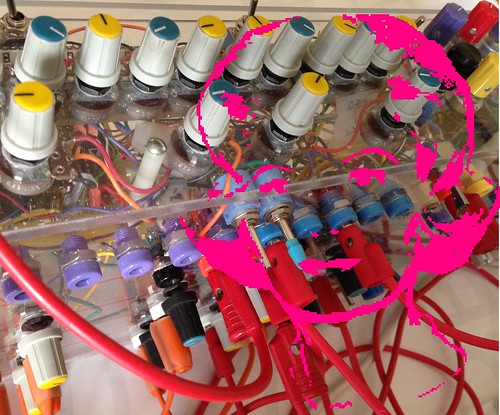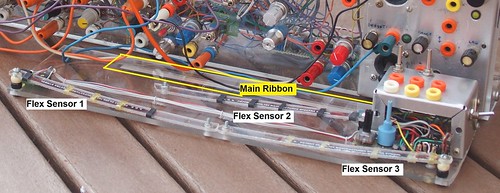Mrs. Cleaver
A sprawling saga of subversion
Barbara Billingsley, MiniMoog Tyranny, Recycling, and the Powers of Two, what do they have in common? Well, they’re all featured in the device you see below!
Let’s find out why.
The Story: Diary of a Mad Housewife
The idea for Mrs. Cleaver was inspired in 2010 when Korg announced a tiny plastic all-analog monosynth, called the ‘Monotron’, for $50. That was just too much cheap fun for me to ignore, and then they iced that cake thickly & sweetly by publishing the schematic even before the things were even in the stores in my town! Holy Cow! what a DIY hackers delight! Of course, it was all surface-mount construction (see my complaint in the sixth paragraph here ). But I could just about squeeze my tools into it and it was a GREAT-sounding little circuit. It started me thinking about monosynths.
In the old testament of analog synthesizers the MiniMoog is Abraham. You can argue about whether it was the absolute ‘first’ monosynth. But there is no dispute that its architecture became the paradigm for the ‘classic’ analog synthesizer ‘voice’. Before the MiniMoog, The elements of an analog synth voice had to be patched together in order to be heard. Moog’s fledgling company took a chance in 1970. They built a keyboard synthesizer that needed no tangle of patch cords. Instead, the modules (oscillators, filters etc.) were connected ‘under the hood’ in what they, rather arbitrarily, assumed would be the most useful configuration for a performing keyboardist. Turns out they were on to something, because in a very short time after the release of their new ‘MiniMoog’, Moog transformed from an esoteric and academic enterprise to a de-facto standard brand and a household name. In the way that ‘Kleenex’ became synonymous with tissue paper. By 1972, most musicians were calling any synthesizer they saw onstage ‘a moog’. The MiniMoog’s configuration , for better or worse, became the expected standard model for a monophonic analog synthesizer voice.
Fast-forward 40 years to 2010 and the tiny Korg monosynth on my workbench was an abbreviated, but still-faithful model of the MiniMoog voice.
This paradigm for a synth voice was so deeply entrenched in the synthesizer design industry that when polyphonic instruments were demanded. Some designers of integrated circuit chips themselves figured out how to put most of the circuitry of a MiniMoog on a single chip(!) so that , for instance, 5 of these chips in your instrument could yield the sound of 5 MiniMoogs, one under each finger of one-hand. This was manifested by Dave Smith’s wonderful-sounding Prophet-5 polysynth in 1978.
I lived though all this synth design history and that tiny plastic Korg monotron led me to ponder how a doctrine conceived arbitrarily by some guys in Moog’s Trumansburg workshop became and remained an unassailable dogma 40 years later…
… and what I might do to subvert that.
Cultures love conventions. We love our myths. They are our touchstones. No matter how implausible, outdated, or unwieldy they become. We cling to them because they are familiar, and the root of the word familiar is ‘family’. There is much truth in the aphorism: “Audiences don’t know what they like, they like what they KNOW”. And the MiniMoog’s VCO->Mixer->VCF->VCA signal chain is what keyboardists KNOW. To be sure, it’s a very practical and serviceable model. Otherwise it would never have succeeded, much less dominated commercially. But there were other contemporaneous models that made fantastic music. For instance Don Buchla’s 200-series system was an approach that was arguable much more powerful and flexible. But no one ever enshrined a Buchla-259 on a single chip.
To keyboardists, the MiniMoog model is white bread, mom, & apple pie. It is June Cleaver. Whatever mischief and muddy shoes you got up to out in the wilds of Mayfield, you always came home to mom. That is how June Cleaver, implausibly doing the the housework in pumps and pearls, became the emblem for this project and the name of the instrument.
I decided to hack this stolid monosynth model. But not hack it back into the component modules and just rearrange them. That’s simply reverting to the modular synthesizer that Moog eschewed,. I wanted to leave the monosynths intact but integrate them into a larger structure that would resist allowing them to sound familiar. Like noticing that Mrs. Cleaver just got herself a tiny pearl septum piercing!
Put less metaphorically, I deployed 3 intact monosynth voices, A pair of the aforementioned monosynth-on-a-chip devices, and a Korg monotron that was augmented with external voltage control features and an added VCO. The big twist was that they would be integrated into a macro structure that allowed for them to mix and interact in ways that would defy their inherently conventional designs. It bears mentioning that I chose to deploy a PAIR of the on-chip monosynths in order to exploit the outsized musical power of TWO. This is a lesson taken from two of the most original thinkers in synthesizer design, Don Buchla and John Chowning. Both designers recognized that, in music, 1 + 1 equals much more than two (!) It always equals at least three! To wit, If you play two notes , say: C and F# , you will hear the C and the F# , AND the INTERVAL between those notes …. AND a whole spectrum of moving harmonics besides. Buchla rendered this magical two-fer in his sublime design of the original 259 complex waveform generator. Chowning manifested this principle in his seminal work on FM synthesis . My scheme in Mrs. Cleaver is much more modest than these two genius/engineers but it uses the principle that the human ear picks up a lot of color when two ALMOST similar sounds overlap or alternate so fast that they start to ‘blur’ together. To make this happen I devised a crossfader that was tailored to use the VCAs on board the two monosynth chips.
In an overview like this (above) It’s fair to say that for all my talk about about some grand subversion scheme, all I did was put 3 classic monosynth voices in the middle of a hand full of VCA’s and a crossfader. In concept this hardly seems very revolutionary. But I submit that VCA’s are grossly underrated in terms of the depth of their effect. VCAs can impart remarkable animation and dynamism to a system. I once loaned Mrs. Cleaver to a very experienced synthesist who felt that, because the cores were classic monosynths, he could approach this ‘electronium’ more easily than my usual byzantine work. When he returned it to me his comment was that he’d never before heard the kind of timbres he produced with this instrument and that he’d never underestimate the difference that ‘mere’ VCA’s could make again.
The Controllers: Touching Mrs. Cleaver
In terms of the manual controls I decided not to indulge the subversion theme to the extent of including a keyboard as the primary controller. So I used my old fallback, the ribbon, as the primary controller. I connected a very complex array of gated control voltage functions to the ribbon’s gate output.
I built 3 other tactile controllers that use flex sensors on bendy plastic strips to send control voltages. The haptic ‘feel’ of these controllers is markedly different from the feel of fingertip-sized pressure sensors and I placed them around the ribbon in places that were convenient for the fingers that were surplus to the playing of the ribbon.
Another device that is crucial to the character of Mrs. Cleaver is the ‘Strange LFO’ This is a voltage-controlled LFO with a widely adjustable frequency range that outputs a square wave and either a sawtooth or triangle wave. Another twist is that this LFO responds to CV in an inverted fashion; the lower the control voltage, the higher the LFO frequency. This was implemented to accommodate the output quirks of the flex-sensor controllers. This LFO is optimized to make a reciprocating crossfade between the twin ‘chip’ voices when patched to the output VCAs of these voices. (shown in the block diagram) When this crossfade is buzzing at audio rates, this effect makes a very rich clangorous FM-like sound of the dual voices and then when driven smoothly down below audio rates this crossfade breaks the two voices down, exposing their individual timbres The various LFO waveshapes also create very prominent differences in the character of this crossfade effect.
Recycling: What are little girls made of?
I’ve confessed repeatedly on this website that my methods are not tidy, efficient engineering. Very often , with screwdriver in hand, I will look askance at a gadget I built in the past that ‘seemed like a good idea at the time’ and realize that it will serve a newer vision better, and shortly afterwards this sacrificial device has been ‘recycled’ for its parts. I’m pretty ruthless about this with commercial devices too. The things I’ve done to the vintage analog synthesizers I own have made me a legendary pariah among ‘collectors’. That’s suits me just fine. My opinion of collectors and their mindset returns their scandalized disdain. I will also sometimes make a design choice based on the fact that I have a perfectly functional salvaged circuit or component right on hand. It’s analogous to a frugal cook who hates to see any leftovers go to waste.
Mrs. Cleaver is a real bride of Frankenstein assemblage. Obviously the Monotron was appropriated from Korg. The twin monosynth chips were scavenged from a mortally wounded 80’s drum machine(!) and…. feast your eyes on this lurid popinjay from the depths of my naive past:
See if you can spot it in the second & third photos at the top of this article.
Want-Not? Waste-Not!
And as a really lovely piece of serendipity, the box, controller and the dedicated power-supply all fit perfectly inside a slightly musty, but otherwise elegant, vintage tenor sax case I found in my useful-salvage pile.
And as a final note:
Mrs. Cleaver is another one of the instruments in my oeuvre that thumbs its nose at my own categorizations. I’ve decided to include it with the electroniums on a technicality; namely, it operates on a rather unusual power supply and thus it is not advisable to patch it to other modular synths. That ‘standalone-ness’ is why it’s here. On the other hand it requires patching to make a sound so it’s also arguably a modular synthesizer too.








Comments are closed.